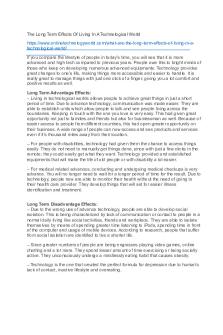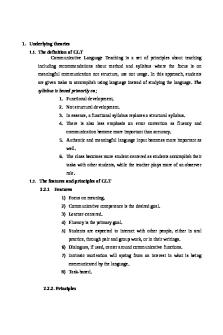Communicative Language Teaching Método de enseñanza de inglés PDF

| Title | Communicative Language Teaching Método de enseñanza de inglés |
|---|---|
| Author | Yamán Yousef Hathat |
| Course | Didáctica De La Lengua Inglesa |
| Institution | Universidad de Alicante |
| Pages | 5 |
| File Size | 138.8 KB |
| File Type | |
| Total Downloads | 87 |
| Total Views | 153 |
Summary
Se trata de un trabajo que hice sobre uno de los métodos de enseñanza en educacion primaria de la lengua inglesa....
Description
University of Alicante Primary Education
COMMUNICATIVE LANGUAGE TEACHING DIDÁCTICA DE LA LENGUA INGLESA PARA LA EDUCACIÓN PRIMARIA
23.02.027 BELDA SOLER, L GISBERT PASTOR, S. VENTEO PÉREZ, I. RUÍZ ALEDO, Mª. FERNÁNDEZ-CAÑADAS CABRERA, N. [NOMBRE DE LA COMPAÑÍA] [Dirección de la compañía]
METHOD 6. COMMUNICATIVE LANGUAGE TEACHING
Communicative language teaching (CLT), focuses on Language Teaching in which teachers prioritize the interaction as a way of learning a foreign language. This method starts from the notional-functional method, the communicative approach also incises on helping students to use the language that is being learned in a big variety of contexts and it also gives importance to learning the functions of language. The difference between our method and the audiolingual one is that the communicative approach’s main objective is to help students to know how to communicate instead of doing perfect grammatical structures and pronunciate well. This kind of learning of a foreign language is evaluated taking into account how the student develops its communicative competence, that is to say, the student’s capacity to use his knowledges about formal aspects and sociolinguistics of the language to communicate suitably.
The main characteristic of the Communicative Language Teaching is its methodology because it defends that communication is the best way to learn a foreign language. Therefore, this method is closely related to the Communicative competence. In consequence, students are the chiefs of their own learning, which means that the teacher is a simple organizer. On the one hand, it involves that the teaching encourages students to study foreign languages because the teachers take into account their interests, culture and experiences. On the other hand, this method is characterized for individualizing the children education and making it easier.
First of all, teachers have to pay more attention to the practise than theory. To do this, a good practise consists in: Teaching the original language to suit any situation, also it is necessary to use the vocabulary in different contexts; teaching
with an easy and visual form so that students will be more motivated; improving the skill speaking, and finally, organize activities for cooperative work. Some activities to practise communicative language in class are: role playing such as markets conversations, different points of view in a family, friendships conversations, interviews, etc. Besides, we can use games, work in pairs exchanging information to correct mistakes, sing songs and perform mini plays of theatres. To conclude, the advantages of tis method are: ● Through this method, the students develop the language functions, also they develop their speaking skill. ● Attaches great importance to the experiences of the students (their daily dialogues) about practice and that way, it achieves a greater performance of the language. ● It gives the opportunity to work in groups,in pairs, also proposes activities that stimulate the speech fluency. (role plays) ● Introduces real texts in the learning situations. ● It creates in the child sentences that have meaning. And he disadvantatges are: ● As this approach is one of the most current nowadays, teachers do not know how to use it to the top. They do not take the most benefit of what it offers and it causes a bad interpretation of it. Nevertheless, not all courses which apply this communicative language teaching are limited only for this activities. Some teachers, for example, ask sometimes their students to do grammatical exercises or to do some non-communicative automatism exercises. To sum up, the essence of this method is that the students live the language and not just memorizing. citethisforme.com :)
BIBLIOGRAPHY
laguna, J. (2017). VENTAJAS Y DESVENTAJAS DEL ENF COMUNICATIVO. [online] Petitlac1103.blogspot.com.es. Available at: http://petitlac1103.blogspot.com.es/2009/06/ventajas-y-desventajas-del-enf.html [Accessed 22 Feb. 2017] Power Point: LESSON 2: PROCEDURES IN THE TEACHING OF FOREIGN LANGUAGES IN PRIMARY EDUCATION....
Similar Free PDFs

Communicative Language Teaching
- 3 Pages

Task-based language teaching
- 238 Pages

English Language Teaching
- 9 Pages

English Language Teaching
- 7 Pages

Communicative
- 20 Pages

Methodology in Language Teaching
- 433 Pages

English Language Teaching
- 16 Pages

LANGUAGE TEACHING MEDIA
- 1 Pages
Popular Institutions
- Tinajero National High School - Annex
- Politeknik Caltex Riau
- Yokohama City University
- SGT University
- University of Al-Qadisiyah
- Divine Word College of Vigan
- Techniek College Rotterdam
- Universidade de Santiago
- Universiti Teknologi MARA Cawangan Johor Kampus Pasir Gudang
- Poltekkes Kemenkes Yogyakarta
- Baguio City National High School
- Colegio san marcos
- preparatoria uno
- Centro de Bachillerato Tecnológico Industrial y de Servicios No. 107
- Dalian Maritime University
- Quang Trung Secondary School
- Colegio Tecnológico en Informática
- Corporación Regional de Educación Superior
- Grupo CEDVA
- Dar Al Uloom University
- Centro de Estudios Preuniversitarios de la Universidad Nacional de Ingeniería
- 上智大学
- Aakash International School, Nuna Majara
- San Felipe Neri Catholic School
- Kang Chiao International School - New Taipei City
- Misamis Occidental National High School
- Institución Educativa Escuela Normal Juan Ladrilleros
- Kolehiyo ng Pantukan
- Batanes State College
- Instituto Continental
- Sekolah Menengah Kejuruan Kesehatan Kaltara (Tarakan)
- Colegio de La Inmaculada Concepcion - Cebu







